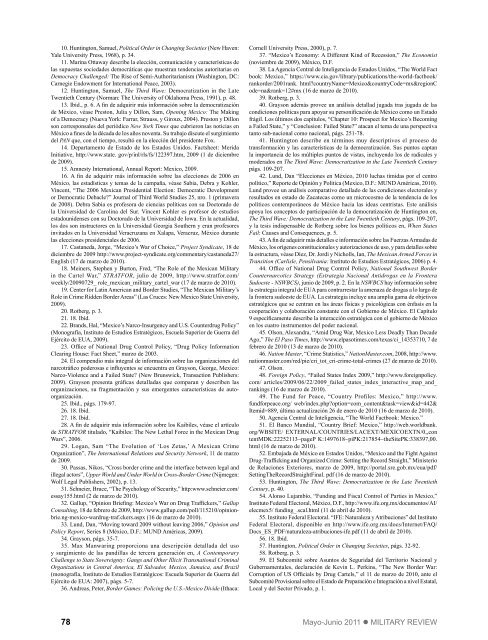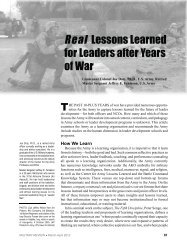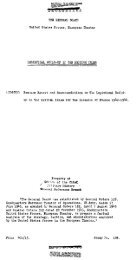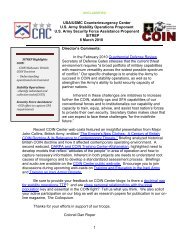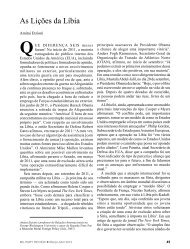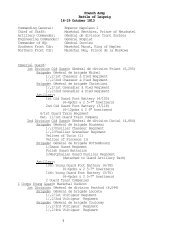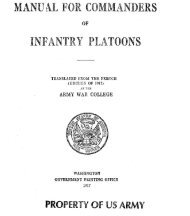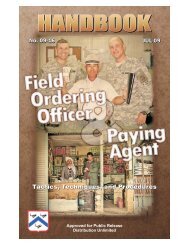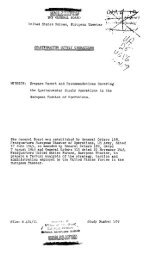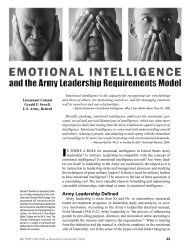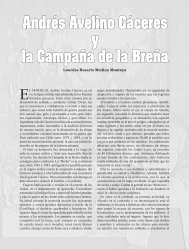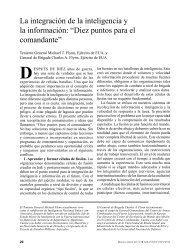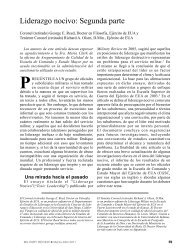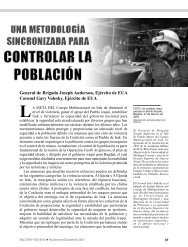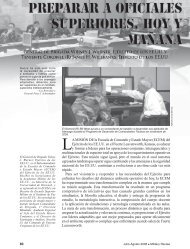Una guía práctica para el diseño - US Army Combined Arms Center ...
Una guía práctica para el diseño - US Army Combined Arms Center ...
Una guía práctica para el diseño - US Army Combined Arms Center ...
Create successful ePaper yourself
Turn your PDF publications into a flip-book with our unique Google optimized e-Paper software.
10. Huntington, samu<strong>el</strong>, Political Order in Changing Societies (new Haven:<br />
Yale university Press, 1968), p. 34.<br />
11. marina ottaway describe la <strong>el</strong>ección, comunicación y características de<br />
las supuestas sociedades democráticas que muestran tendencias autoritarias en<br />
Democracy Challenged: the rise of semi-authoritarianism (Washington, DC:<br />
Carnegie Endowment for International Peace, 2003).<br />
12. Huntington, samu<strong>el</strong>, The Third Wave: Democratization in the Late<br />
twentieth Century (norman: the university of oklahoma Press, 1991), p. 48.<br />
13. Ibíd., p. 6. a fin de adquirir más información sobre la democratización<br />
de México, véase Preston, Julia y Dillon, Sam, Opening Mexico: The Making<br />
of a Democracy (nueva York: Farrar, strauss, y Giroux, 2004). Preston y Dillon<br />
son corresponsales d<strong>el</strong> periódico New York Times que cubrieron las noticias en<br />
méxico a fines de la década de los años noventa. su trabajo discute <strong>el</strong> surgimiento<br />
d<strong>el</strong> PAN que, con <strong>el</strong> tiempo, resultó en la <strong>el</strong>ección d<strong>el</strong> presidente Fox.<br />
14. Departamento de Estado de los Estados unidos. Factsheet: merida<br />
Initiative, http://www.state. gov/p/inl/rls/fs/122397.htm, 2009 (1 de diciembre<br />
de 2009).<br />
15. amnesty International, annual report: mexico, 2009.<br />
16. a fin de adquirir más información sobre las <strong>el</strong>ecciones de 2006 en<br />
México, las estadísticas y temas de la campaña, véase Sabia, Debra y Kohler,<br />
Vincent, “the 2006 mexican Presidential Election: Democratic Dev<strong>el</strong>opment<br />
or Democratic Debacle?” Journal of third World studies 25, nro. 1 (primavera<br />
de 2008). Debra sabia es profesora de ciencias políticas con su Doctorado de<br />
la Universidad de Carolina d<strong>el</strong> Sur. Vincent Kohler es profesor de estudios<br />
estadounidenses con su Doctorado de la universidad de Iowa. En la actualidad,<br />
los dos son instructores en la Universidad Georgia Southern y eran profesores<br />
invitados en la Universidad Veracruzana en Xalapa, Veracruz, México durante<br />
las <strong>el</strong>ecciones presidenciales de 2006.<br />
17. Castaneda, Jorge, “mexico’s War of Choice,” Project Syndicate, 18 de<br />
diciembre de 2009 http://www.project-syndicate.org/commentary/castaneda27/<br />
English (17 de marzo de 2010).<br />
18. meiners, stephen y Burton, Fred, “the role of the mexican military<br />
in the Cart<strong>el</strong> War,” STRATFOR, julio de 2009, http://www.stratfor.com/<br />
weekly/20090729_ role_mexican_military_cart<strong>el</strong>_war (17 de marzo de 2010).<br />
19. <strong>Center</strong> for latin american and Border studies, “the mexican military’s<br />
role in Crime ridden Border areas” (las Cruces: new mexico state university,<br />
2009).<br />
20. rotberg, p. 3.<br />
21. 18. Ibíd.<br />
22. Brands, Hal, “mexico’s narco-Insurgency and u.s. Counterdrug Policy”<br />
(monografía, Instituto de Estudios Estratégicos, Escu<strong>el</strong>a superior de Guerra d<strong>el</strong><br />
Ejército de Eua, 2009).<br />
23. office of national Drug Control Policy, “Drug Policy Information<br />
Clearing House: Fact sheet,” marzo de 2003.<br />
24. El compendio más integral de información sobre las organizaciones d<strong>el</strong><br />
narcotráfico poderosas e influyentes se encuentra en Grayson, George, mexico:<br />
narco-Violence and a Failed state? (new Brunswick, transaction Publishers:<br />
2009). Grayson presenta gráficas detalladas que com<strong>para</strong>n y describen las<br />
organizaciones, su fragmentación y sus emergentes características de autoorganización.<br />
25. Ibíd., págs. 179-97.<br />
26. 18. Ibíd.<br />
27. 18. Ibíd.<br />
28. a fin de adquirir más información sobre los Kaibiles, véase <strong>el</strong> artículo<br />
de STRATFOR titulado, “Kaibiles: the new lethal Force in the mexican Drug<br />
Wars”, 2006.<br />
29. logan, sam “the Evolution of ‘los Zetas,’ a mexican Crime<br />
Organization”, The International R<strong>el</strong>ations and Security Network, 11 de marzo<br />
de 2009.<br />
30. Passas, Nikos, “Cross border crime and the interface between legal and<br />
illegal actors”, Upper World and Under World in Cross-Border Crime (nijmegen:<br />
Wolf legal Publishers, 2002), p. 13.<br />
31. schneier, Bruce, “the Psychology of security,” http:www.schneier.com/<br />
essay 155.html (2 de marzo de 2010).<br />
32. Gallup, “opinion Briefing: mexico’s War on Drug traffickers,” Gallup<br />
Consulting, 18 de febrero de 2009, http://www.gallup.com/poll/115210/opinionbrie.ng-mexico-war<br />
drug-traf.ckers.aspx (16 de marzo de 2010).<br />
33. lund, Dan, “moving toward 2009 without leaving 2006,” Opinion and<br />
Policy Report, series 8 (méxico, D.F.: munD américas, 2009).<br />
34. Grayson, págs. 35-7.<br />
35. max manwaring proporciona una descripción detallada d<strong>el</strong> uso<br />
y surgimiento de las pandillas de tercera generación en, A Contemporary<br />
Challenge to State Sovereignty: Gangs and Other Illicit Transnational Criminal<br />
Organizations in Central America, El Salvador, Mexico, Jamaica, and Brazil<br />
(monografía, Instituto de Estudios Estratégicos: Escu<strong>el</strong>a superior de Guerra d<strong>el</strong><br />
Ejército de Eua: 2007), págs. 5-7.<br />
36. Andreas, Peter, Border Games: Policing the U.S.-Mexico Divide (Ithaca:<br />
Corn<strong>el</strong>l university Press, 2000), p. 7.<br />
37. “mexico’s Economy: a Different Kind of recession,” The Economist<br />
(noviembre de 2009), méxico, D.F.<br />
38. la agencia Central de Int<strong>el</strong>igencia de Estados unidos, “the World Fact<br />
book: mexico,” https://www.cia.gov/library/publications/the-world-factbook/<br />
rankorder/2001rank. html?countryname=mexico&countryCode=mx®ionC<br />
ode=na&rank=12#mx (16 de marzo de 2010).<br />
39. rotberg, p. 3.<br />
40. Grayson además provee un análisis detallad jugada tras jugada de las<br />
condiciones políticas <strong>para</strong> apoyar su personificación de méxico como un Estado<br />
frágil. los últimos dos capítulos, “Chapter 10: Prospect for mexico’s Becoming<br />
a Failed state,” y “Conclusion: Failed state?” atacan <strong>el</strong> tema de una perspectiva<br />
tanto sub-nacional como nacional, págs. 251-78.<br />
41. Huntington describe en términos muy descriptivos <strong>el</strong> proceso de<br />
transformación y las características de la democratización. sus puntos captan<br />
la importancia de los múltiples puntos de vistas, incluyendo los de radicales y<br />
moderados en The Third Wave: Democratization in the Late Twentieth Century<br />
págs. 109-207.<br />
42. lund, Dan “Elecciones en méxico, 2010 luchas tímidas por <strong>el</strong> centro<br />
político,” reporte de opinión y Politica (mexico, D.F.: munD américas, 2010).<br />
Lund provee un análisis com<strong>para</strong>tivo detallado de las condiciones <strong>el</strong>ectorales y<br />
resultados en estado de Zacatecas como un microcosmo de la tendencia de los<br />
políticos contemporáneos de México hacia las ideas centristas. Este análisis<br />
apoya los conceptos de participación de la democratización de Huntington en,<br />
The Third Wave: Democratization in the Late Twentieth Century, págs. 109-207,<br />
y la tesis indispensable de Rotberg sobre los bienes políticos en, When States<br />
Fail: Causes and Consequences, p. 5.<br />
43. a fin de adquirir más detalles e información sobre las Fuerzas armadas de<br />
México, los orígenes constitucionales y autorizaciones de uso, y <strong>para</strong> detalles sobre<br />
la estructura, véase Díez, Dr. Jordi y nicholls, Ian, The Mexican Armed Forces in<br />
Transition (Carlisle, Pensilvania: Instituto de Estudios Estratégicos, 2006) p. 4.<br />
44. office of national Drug Control Policy, National Southwest Border<br />
Counternarcotics Strategy (Estrategia Nacional Antidrogas en la Frontera<br />
Sudoeste - NSWBCS), junio de 2009, p. 2. En la NSWBCS hay información sobre<br />
la estrategia integral de EUA <strong>para</strong> contrarrestar la amenaza de drogas a lo largo de<br />
la frontera sudoeste de EUA. La estrategia incluye una amplia gama de objetivos<br />
estratégicos que se centran en las áreas físicas y psicológicas con énfasis en la<br />
cooperación y colaboración constante con <strong>el</strong> Gobierno de méxico. El Capítulo<br />
9 específicamente describe la interacción estratégica con <strong>el</strong> gobierno de méxico<br />
en los cuatro instrumentos d<strong>el</strong> poder nacional.<br />
45. Olson, Alexandra, “Amid Drug War, Mexico Less Deadly Than Decade<br />
Ago,” The El Paso Times, http://www.<strong>el</strong>pasotimes.com/texas/ci_14353710, 7 de<br />
febrero de 2010 (13 de marzo de 2010).<br />
46. Nation Master, “Crime Statistics,” NationMaster.com, 2008, http://www.<br />
nationmaster.com/red/pie/cri_tot_cri-crime-total-crimes (27 de marzo de 2010).<br />
47. Olson.<br />
48. Foreign Policy, “Failed states Index 2009,” http://www.foreignpolicy.<br />
com/ articles/2009/06/22/2009_failed_states_index_interactive_map_and_<br />
rankings (16 de marzo de 2010).<br />
49. the Fund for Peace, “Country Profiles: mexico,” http://www.<br />
fundforpeace.org/ web/index.php?option=com_content&task=view&id=442&<br />
Itemid=889, última actualización 26 de enero de 2010 (16 de marzo de 2010).<br />
50. agencia Central de Int<strong>el</strong>igencia, “the World Factbook: mexico.”<br />
51. El Banco mundial, “Country Brief: mexico,” http://web.worldbank.<br />
org/WBsItE/ EXtErnal/CountrIEs/laCEXt/mEXICoEXtn/0,,con<br />
tentmDK:22252113~pageP K:1497618~piPK:217854~thesitePK:338397,00.<br />
html (16 de marzo de 2010).<br />
52. Embajada de méxico en Estados unidos, “mexico and the Fight against<br />
Drug-trafficking and organized Crime: setting the record straight,” ministerio<br />
de r<strong>el</strong>aciones Exteriores, marzo de 2009, http://portal.sre.gob.mx/eua/pdf/<br />
settingtherecordstraightFinal. pdf (16 de marzo de 2010).<br />
53. Huntington, The Third Wave: Democratization in the Late Twentieth<br />
Century, p. 40.<br />
54. Alonso Lujambío, “Funding and Fiscal Control of Parties in Mexico,”<br />
Instituto Federal Electoral, méxico, D.F., http://www.ife.org.mx/documentos/aI/<br />
<strong>el</strong>ecmex5/ funding_.scal.html (11 de abril de 2010).<br />
55. Instituto Federal Electoral. “IFE: naturaleza y atribuciones” d<strong>el</strong> Instituto<br />
Federal Electoral, disponible en http://www.ife.org.mx/docs/Internet/FaQ/<br />
Docs_Es_PDF/naturaleza-atribuciones-ife.pdf (11 de abril de 2010).<br />
56. 18. Ibíd.<br />
57. Huntington, Political Order in Changing Societies, págs. 32-92.<br />
58. Rotberg, p. 3.<br />
59. El subcomité sobre asuntos de seguridad d<strong>el</strong> territorio nacional y<br />
Gubernamentales, declaración de Kevin l. Perkins, “the new Border War:<br />
Corruption of us officials by Drug Cart<strong>el</strong>s,” <strong>el</strong> 11 de marzo de 2010, ante <strong>el</strong><br />
subcomité Provisional sobre <strong>el</strong> Estado de Pre<strong>para</strong>ción e Integración a niv<strong>el</strong> Estatal,<br />
local y d<strong>el</strong> sector Privado, p. 1.<br />
78 Mayo-Junio 2011 MILITARY REVIEW


